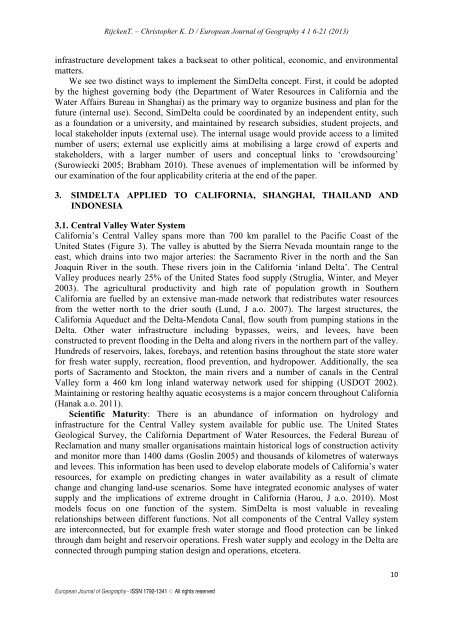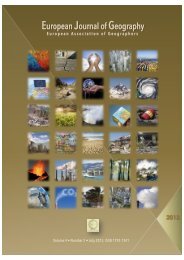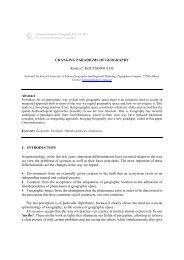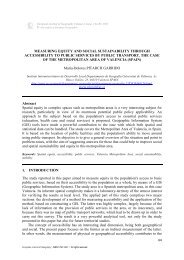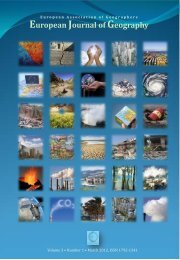European Journal of Geography
European Journal of Geography
European Journal of Geography
Create successful ePaper yourself
Turn your PDF publications into a flip-book with our unique Google optimized e-Paper software.
RijckenT. – Christopher K. D / <strong>European</strong> <strong>Journal</strong> <strong>of</strong> <strong>Geography</strong> 4 1 6-21 (2013)<br />
infrastructure development takes a backseat to other political, economic, and environmental<br />
matters.<br />
We see two distinct ways to implement the SimDelta concept. First, it could be adopted<br />
by the highest governing body (the Department <strong>of</strong> Water Resources in California and the<br />
Water Affairs Bureau in Shanghai) as the primary way to organize business and plan for the<br />
future (internal use). Second, SimDelta could be coordinated by an independent entity, such<br />
as a foundation or a university, and maintained by research subsidies, student projects, and<br />
local stakeholder inputs (external use). The internal usage would provide access to a limited<br />
number <strong>of</strong> users; external use explicitly aims at mobilising a large crowd <strong>of</strong> experts and<br />
stakeholders, with a larger number <strong>of</strong> users and conceptual links to ‘crowdsourcing’<br />
(Surowiecki 2005; Brabham 2010). These avenues <strong>of</strong> implementation will be informed by<br />
our examination <strong>of</strong> the four applicability criteria at the end <strong>of</strong> the paper.<br />
3. SIMDELTA APPLIED TO CALIFORNIA, SHANGHAI, THAILAND AND<br />
INDONESIA<br />
3.1. Central Valley Water System<br />
California’s Central Valley spans more than 700 km parallel to the Pacific Coast <strong>of</strong> the<br />
United States (Figure 3). The valley is abutted by the Sierra Nevada mountain range to the<br />
east, which drains into two major arteries: the Sacramento River in the north and the San<br />
Joaquin River in the south. These rivers join in the California ‘inland Delta’. The Central<br />
Valley produces nearly 25% <strong>of</strong> the United States food supply (Struglia, Winter, and Meyer<br />
2003). The agricultural productivity and high rate <strong>of</strong> population growth in Southern<br />
California are fuelled by an extensive man-made network that redistributes water resources<br />
from the wetter north to the drier south (Lund, J a.o. 2007). The largest structures, the<br />
California Aqueduct and the Delta-Mendota Canal, flow south from pumping stations in the<br />
Delta. Other water infrastructure including bypasses, weirs, and levees, have been<br />
constructed to prevent flooding in the Delta and along rivers in the northern part <strong>of</strong> the valley.<br />
Hundreds <strong>of</strong> reservoirs, lakes, forebays, and retention basins throughout the state store water<br />
for fresh water supply, recreation, flood prevention, and hydropower. Additionally, the sea<br />
ports <strong>of</strong> Sacramento and Stockton, the main rivers and a number <strong>of</strong> canals in the Central<br />
Valley form a 460 km long inland waterway network used for shipping (USDOT 2002).<br />
Maintaining or restoring healthy aquatic ecosystems is a major concern throughout California<br />
(Hanak a.o. 2011).<br />
Scientific Maturity: There is an abundance <strong>of</strong> information on hydrology and<br />
infrastructure for the Central Valley system available for public use. The United States<br />
Geological Survey, the California Department <strong>of</strong> Water Resources, the Federal Bureau <strong>of</strong><br />
Reclamation and many smaller organisations maintain historical logs <strong>of</strong> construction activity<br />
and monitor more than 1400 dams (Goslin 2005) and thousands <strong>of</strong> kilometres <strong>of</strong> waterways<br />
and levees. This information has been used to develop elaborate models <strong>of</strong> California’s water<br />
resources, for example on predicting changes in water availability as a result <strong>of</strong> climate<br />
change and changing land-use scenarios. Some have integrated economic analyses <strong>of</strong> water<br />
supply and the implications <strong>of</strong> extreme drought in California (Harou, J a.o. 2010). Most<br />
models focus on one function <strong>of</strong> the system. SimDelta is most valuable in revealing<br />
relationships between different functions. Not all components <strong>of</strong> the Central Valley system<br />
are interconnected, but for example fresh water storage and flood protection can be linked<br />
through dam height and reservoir operations. Fresh water supply and ecology in the Delta are<br />
connected through pumping station design and operations, etcetera.<br />
<strong>European</strong> <strong>Journal</strong> <strong>of</strong> <strong>Geography</strong> - ISSN 1792-1341 © All rights reserved<br />
10


